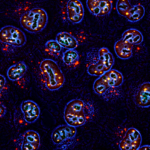Link to Pubmed [PMID] – 10779416
Blood 2000 May;95(9):2748-52
The tumor-suppressive promyelocytic leukemia (PML) protein of acute promyelocytic leukemia (APL) has served as one of the defining components of a class of distinctive nuclear bodies (NBs). PML is delocalized from NBs in APL cells and is degraded in cells infected by several viruses. In these cells, NBs are disrupted, leading to the aberrant localization of NB proteins. These results have suggested a critical role for the NB in immune response and tumor suppression and raised the question of whether PML is crucial for the formation or stability of NB. In addition, PML is, among other proteins, covalently modified by SUMO-1. However, the functional relevance of this modification is unclear. Here, we show in primary PML(-/-) cells of various histologic origins, that in the absence of PML, several NB proteins such as Sp100, CBP, ISG20, Daxx, and SUMO-1 fail to accumulate in the NB and acquire aberrant localization patterns. Transfection of PML in PML(-/-) cells causes the relocalization of NB proteins. By contrast, a PML mutant that can no longer be modified by SUMO-1 fails to do so and displays an aberrant nuclear localization pattern. Therefore, PML is required for the proper formation of the NB. Conjugation to SUMO-1 is a prerequisite for PML to exert this function. These data shed new light on both the mechanisms underlying the formation of the NBs and the pathogenesis of APL. (Blood. 2000;95:2748-2752)

